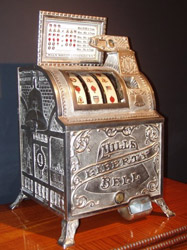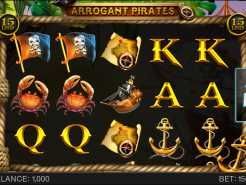The Operator Bell & Silent Bell
In 1891, two men in Brooklyn, named Pitt and Sittman had developed what would form the basis of all the slot machines to ever come in future. Harnessing the popularity of the game of poker, which had become a rage at that time, this machines gained sky rocketing fame in the city of New York, and soon snatched the top spot in the gaming industry. However, the aspect that set these machines apart from the modern day machines was that you were never paid out in money—so what was done was that the winner would be offered some drinks usually or some cigarettes. The odds of winning were tempered by removing certain cards from the deck. Not only this, the arrangement of the drums could also be changed depending upon the choice of the owner.
The Liberty Bell

The Liberty Bell (Mills Liberty Bell) had the symbol of the Liberty bell cast in iron on its front. Scrolled feet which were embellished substituted the earlier used iron toes. Apart from featuring the bell which would ring if a player achieved a winning combination, there the Jack, Queen and King playing cards which were denoted on the reels of the machine. Apart from just facing his usual losses in profit, Charles Fey’s utter devastation came when the earthquake shattered his factory where slot machines were produced. As the Herbet Mills’ company continued to produce slot machines, Fey died in 1944 after his image became obscure.
The Operator Bell
You could see that slot machines were almost at every place by the year of 1910. The Liberty Bell underwent many modifications and changes, most of them introduced by the Mills Novelty Company. The hugely famous Operator bell was one such example. The company’s influence spread to Europe, and there was many as 5 models of slot machines based on the Liberty Mill which constituted the list of the products sold by the company. 30,000 gambling machines had been sold out by the First World War.
The year of 1919 brought in bad news for the gambling industry, with the onset of the implementation of the prohibition act by the American government, which banned supplying as well as consuming alcohol. It was now speakeasies which contained such machines and where the slot machines were now moved from the bars.
A new era begins. . .
Gambling was legalized in 1978 in Atlantic City—and Bally had gained a major control over the market. A computer programmer was hired by Bally with the aim of enhancing the value of the jackpot without causing any losses to the company. This programmer, by the name of Inge Telnaus, revolutionized the gambling industry by introducing the idea of random number generator—which spewed random numbers corresponding to which the symbols arranged the symbols of the reels.

